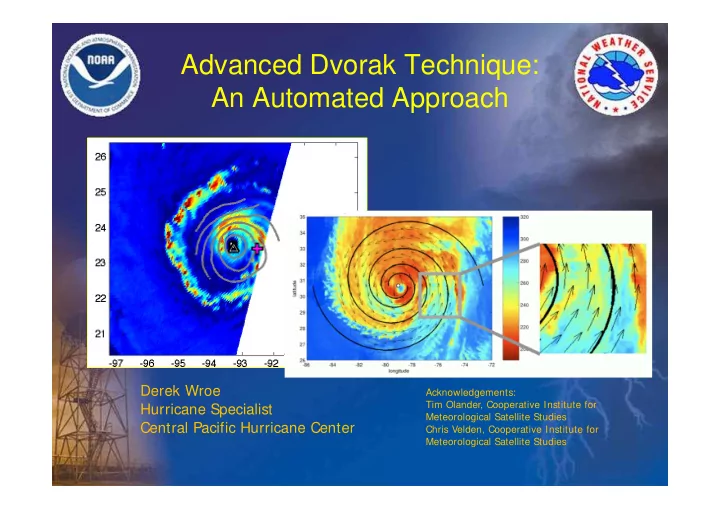

Advanced Dvorak Technique: An Automated Approach Derek Wroe Acknowledgements: Tim Olander, Cooperative Institute for Hurricane Specialist Meteorological Satellite Studies Central Pacific Hurricane Center Chris Velden, Cooperative Institute for Meteorological Satellite Studies
Advanced Dvorak Technique • ADT is a computer based algorithm that objectively determines TC intensity using geostationary IR imagery • ADT is patterned after the traditional Dvorak technique – Output is CI and T number – Utilizes same scene types • Primary motivation: – Remove subjectivity – Promote uniformity • Subjectivity most prominent in cloud type patterning
Advanced Dvorak Technique History • Objective Dvorak Technique (ODT), 1995 – Analyst subjectivity could be introduced by selecting cloud pattern type and applying rules – Only worked on strong tropical storm or hurricane • Automated Objective Dvorak Technique (AODT), 2001 – Completed automated … no human interaction – Worked on any tropical cyclone (tropical depression and higher) – Added new scene types and constraints • Advanced Dvorak Technique, 2004 – Automated center determination – Inclusion of microwave data
Advanced Dvorak Technique • ADT differs from traditional Dvorak technique – Performed hourly – Uses time averaging of T no – Includes some microwave adjustments • Employs automated center finding in stronger systems • Relies on some inputs from NHC, JTWC, or CPHC – Uses center position in weaker systems and as first guess in stronger systems – For C/K/Z MSLP estimate: needs radius of 34 kt winds, outermost closed isobar, and radius of outermost closed isobar
CIMSS ADT OUTPUT Current Intensity # Corresponding MSLP & max winds Adjustments from microwave Final T # Similar to Data T # Scene Classification Dvorak constraints
ADT Increased Precision • ADT produces CI in From Dvorak increments of 0.1, yielding CI MSW MSLP 1.0 25 more precise MSW 1.5 25 2.0 30 1000 2.5 35 997 • ADT using Courtney / Knaff / 3.0 45 991 Zehr approach to determine 3.5 55 984 MSLP 4.0 65 976 4.5 77 966 – Considers TC latitude, size, 5.0 90 954 and environmental pressure 5.5 102 941 6.0 115 927 6.5 127 914 7.0 140 898 7.5 155 879 8.0 170 858
ADT Performance: MSW (kt) (1999 - 2010) • Nearing skill of subjective CIMSS N = 289 Dvorak Dvorak ADT • Still struggles with weak BIAS - 2.5 - 1.9 systems AVG 10.9 7.7 ERROR RMSE 14.3 9.9 Validation from recon-aided Best Track
Advanced Dvorak Technique Passive Microwave Data • Only used in developing systems • Microwave imagery used to search for developing eye structure under dense overcast • If thresholds are met, the Final T in the ADT history file is overridden with a 4.3 or 5.0 • All subsequent T numbers and MET in history file are altered
Advanced Dvorak Technique • CIMSS website: – http://tropic.ssec.wisc.edu/ Access ADT
Questions? Derek Wroe derek.wroe@noaa.gov
Recommend
More recommend